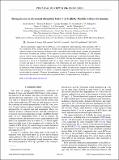Files in this item
Strong increase in ultrasound attenuation below T2 in Sr2RuO4 : possible evidence for domains
Item metadata
| dc.contributor.author | Ghosh, Sayak | |
| dc.contributor.author | Kiely, Thomas G. | |
| dc.contributor.author | Shekhter, Arkady | |
| dc.contributor.author | Jerzembeck, F. | |
| dc.contributor.author | Kikugawa, N. | |
| dc.contributor.author | Sokolov, Dmitry A. | |
| dc.contributor.author | Mackenzie, A. P. | |
| dc.contributor.author | Ramshaw, B. J. | |
| dc.date.accessioned | 2022-11-18T15:30:09Z | |
| dc.date.available | 2022-11-18T15:30:09Z | |
| dc.date.issued | 2022-07-27 | |
| dc.identifier | 282199149 | |
| dc.identifier | c5ef24a1-9ea3-4d6f-a873-1f37f53fcaf4 | |
| dc.identifier | 85135708165 | |
| dc.identifier | 000838079900005 | |
| dc.identifier.citation | Ghosh , S , Kiely , T G , Shekhter , A , Jerzembeck , F , Kikugawa , N , Sokolov , D A , Mackenzie , A P & Ramshaw , B J 2022 , ' Strong increase in ultrasound attenuation below T 2 in Sr 2 RuO 4 : possible evidence for domains ' , Physical Review B , vol. 106 , no. 2 , 024520 . https://doi.org/10.1103/PhysRevB.106.024520 | en |
| dc.identifier.issn | 2469-9969 | |
| dc.identifier.other | RIS: urn:99D033A1D85371365A40145DD60D8910 | |
| dc.identifier.other | RIS: 10.1103/PhysRevB.106.024520 | |
| dc.identifier.uri | https://hdl.handle.net/10023/26436 | |
| dc.description | Funding information: B.J.R. and S.G. acknowledge support from the Office of Basic Energy Sciences of the U.S. Department of Energy under award No. DE-SC0020143. B.J.R. and S.G. acknowledge support from the Cornell Center for Materials Research with funding from the Materials Research Science and Engineering Centers program of the National Science Foundation (cooperative agreement No. DMR-1719875). T.G.K. acknowledges support from the National Science Foundation under Grant No. PHY-2110250. N.K. acknowledges support from Japan Society for the Promotion of Science (JSPS) KAKENHI (Grants No. JP17H06136, No. JP18K04715, and No. 21H01033) and Japan Science and Technology Agency Mirai Program (JPMJMI18A3) in Japan. | en |
| dc.description.abstract | Recent experiments suggest that Sr2RuO4 has a two-component superconducting order parameter (OP). A two-component OP has multiple degrees of freedom in the superconducting state that can result in low-energy collective modes or the formation of domain walls—a possibility that would explain a number of experimental observations including the smallness of the signature of time reversal symmetry breaking at Tc and telegraph noise in critical current experiments. We use resonant ultrasound spectroscopy to perform ultrasound attenuation measurements across the superconducting Tc of Sr2RuO4. We find that compressional sound attenuation increases by a factor of 7 immediately below Tc , in sharp contrast with what is found in both conventional (s-wave) and high-Tc (d-wave) superconductors. Our observations are most consistent with the presence of domain walls that separate different configurations of the superconducting OP. The fact that we only observe an increase in sound attenuation for compressional strains, and not for shear strains, suggests an inhomogeneous superconducting state formed of two distinct, accidentally degenerate superconducting OPs that are not related to each other by symmetry. Whatever the mechanism, a factor of 7 increase in sound attenuation is a singular characteristic that must be reconciled with any potential theory of superconductivity in Sr2RuO4. | |
| dc.format.extent | 8 | |
| dc.format.extent | 936558 | |
| dc.language.iso | eng | |
| dc.relation.ispartof | Physical Review B | en |
| dc.subject | QC Physics | en |
| dc.subject | TK Electrical engineering. Electronics Nuclear engineering | en |
| dc.subject | NDAS | en |
| dc.subject | MCC | en |
| dc.subject.lcc | QC | en |
| dc.subject.lcc | TK | en |
| dc.title | Strong increase in ultrasound attenuation below T2 in Sr2RuO4 : possible evidence for domains | en |
| dc.type | Journal article | en |
| dc.contributor.institution | University of St Andrews. School of Physics and Astronomy | en |
| dc.contributor.institution | University of St Andrews. Condensed Matter Physics | en |
| dc.identifier.doi | https://doi.org/10.1103/PhysRevB.106.024520 | |
| dc.description.status | Peer reviewed | en |
| dc.identifier.url | https://arxiv.org/abs/2109.00041 | en |
This item appears in the following Collection(s)
Items in the St Andrews Research Repository are protected by copyright, with all rights reserved, unless otherwise indicated.

